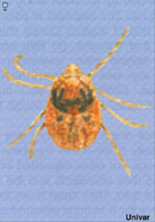Need assistance? Call 800.996.4402
Menu
Need assistance? Call 800.996.4402

The brown dog tick is named for its color and because it is found on domestic dogs. Although it is unusual for a brown dog tick to bite humans, it will do so in the absence of a canine host.
Brown dog ticks prefer dogs as hosts. They typically attach to the ears or between the toes and do not travel very far after dropping off a host. They are unique because they can complete their entire life cycle indoors.
Brown dog ticks rarely attack humans, but they can transmit Rocky Mountain spotted fever and several other tick-borne diseases to dogs including canine ehrlichiosis and canine babesia.
This tick survives best indoors and prefers warm, dry conditions.
The best way to prevent brown dog ticks is cleanliness. Keeping pet areas clean and free of debris can help locate engorged ticks looking to lay eggs and remove them from the house. Pet treatment is also an important prevention tool. Pets should be treated with flea and tick repellent as necessary.
If a tick is found on the body, use fine-tipped tweezers to grasp it as close to the skin’s surface as possible. Pull upward with steady, even pressure. Don’t twist or jerk the tick as this can cause the mouth-parts to break off and remain in the skin. Once the tick is removed, thoroughly clean the bite site with soap and water. Then, flush the tick down the toilet or wrap it in a tissue before disposing in a closed receptacle.






For the very best food safety consulting, auditing and training, please visit our strategic partner, CFS Food Safety